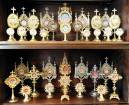


Father Eugene Carrella got hooked on the saints early, as a small boy in Brooklyn. His great-grandmother used to take him to see the shrines in their parish church in Brooklyn, St. Francis of Paola, and tell him about the saints she was especially devoted to.
“We’d go from statue to statue,” he recalled in an interview. He was fascinated, and soon he began collecting statues; he said that he used to beg his mother to buy him statues the way other kids begged for a toy. He started to collect holy cards, too, and more recently he began to collect relics. Today he has a collection of sacred images and objects that is certainly one of a kind in the archdiocese, and probably well beyond it.
In the rectory of St. Adalbert’s parish on Staten Island, where Father Carrella is pastor, statues are everywhere. He has between 300 and 400, from life-size to less than a foot tall. They fill shelves and cabinets and tabletops, and the larger ones stand alone or together in several rooms. A life-size statue of St. Rose of Lima kneels on a prie dieu.
Lined up on shelves are relics enshrined in reliquaries, the ornate vessels designed to display them. Relics of some saints are placed in front of a statue of that saint. Everything is in pristine condition, immaculate and well cared for. Golden reliquaries gleam. Statues that arrived in poor condition have been restored to their original perfection.
Father Carrella said that his mother also collected statues as a girl—so many, in fact, that her own mother used to tell her, “These things belong in church, not in the house. And I hope someday you get one”—a child, that is—“just like yourself.”
“And she did,” Father Carrella said, laughing. The grandmother who said that was the daughter of the great-grandmother who introduced him to the saints.
His collection is unusually extensive, but Father Carrella doesn’t amass holy objects for the sake of having them. He said that it brings him great joy to look at the images of the saints he has loved since he was a boy. Statues affect those who look at them, he said; they inspire reverence for what is holy, and they help people to grow closer to the saints, who in turn bring people closer to God.
Relics have special significance, he said, because they “remind us of a world beyond our own” and “connect us to the communion of saints.”
“We are somehow linked and joined by the relic to a time and place that transcends our own,” he said. Relics also are a reminder that the saints “were people like us, struggling to live a good life, a Christlike life, and in the end they won the battle.”
“We believe that they intercede for us, and people find comfort in that,” he added.
His own list of favorite saints begins with St. Lucy, the first saint his great-grandmother told him about; like her, St. Lucy was from Sicily, he noted. He is devoted to St. Thérèse, who had deep spiritual love for priests and made it one of her apostolates to pray for them, and he has a statue of St. John Vianney, patron of parish priests. But he said that he is inspired by many saints as their feasts occur through the course of the year.
As a boy he began reading about the saints, and he has several shelves of books about them. He can tell stories about every saint whose statue he picks up. “Butler’s Lives of the Saints” is his favorite source.
He began collecting relics after a parishioner gave him a relic of his patron, St. Eugene, along with documentation. When he told a seminary classmate about it, the classmate gave Father Carrella his own collection of about 200 relics.
Father Carrella usually obtains statues from dealers and from sources he finds on the Internet. He obtains relics online also, carefully checking their authenticity, and sometimes from religious orders. He buys reliquaries for every relic he obtains.
Though he can’t cite an amount, his collection has cost him a great deal. “This is where my money goes,” he said, but it’s obvious he believes it was well spent. “When you love something this much, this is what you do, to preserve it…These will never be made again. The molds are not even available.”
His holy cards, carefully mounted in binders, date from the 1800s. Some are lithographs with jewel-like colors.
Father Carrella said that he would love to open an oratory, part chapel and part museum, “where people could come to pray and learn about the saints.”
St. Adalbert’s parish recently held an event, “Treasures of the Church,” an exposition of sacred relics that is presented throughout North America by Father Carlos Martins of the Companions of the Cross. Father Martins delivered a presentation and brought about 200 relics that were displayed in the parish auditorium with images and information on the saints. Father Carrella noted that although the event took place on Memorial Day weekend, more than 400 attended.
The parish holds devotional services throughout the year in honor of saints’ feasts, including Our Lady of Lourdes, St. Agatha, St. Padre Pio and—this week on the 15th and 16th—Our Lady of Mount Carmel, at which the faithful may venerate relics of St. Thérèse, St. Teresa of Avila and St. John of the Cross, all Carmelites.
Father Carrella added that many people tell him how happy they are to find the devotions at St. Adalbert’s, because they can’t find them anywhere else.
“People are hungry for this,” he said.